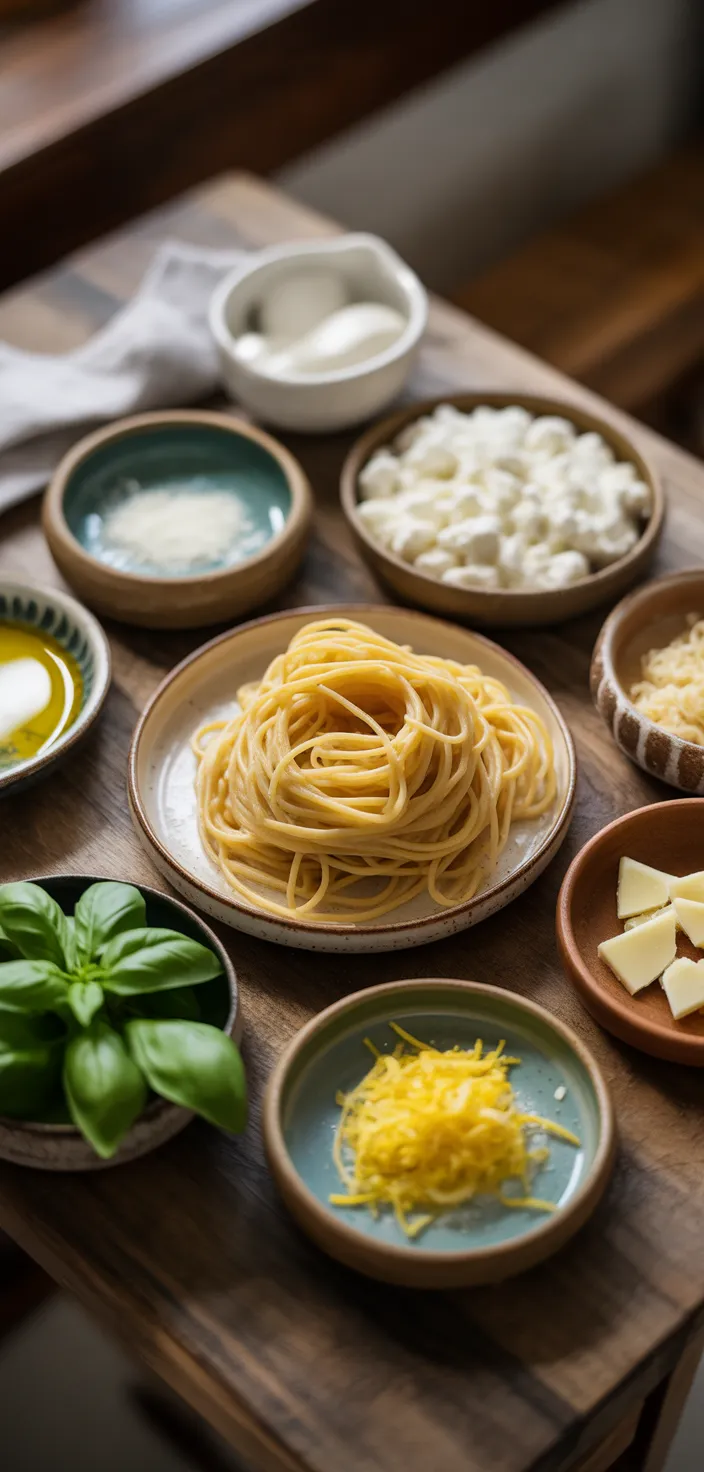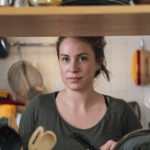I can’t wait to share my Healthy Cottage Cheese Pasta that takes just 15 minutes to make and makes busy weekdays so much easier for lunch or dinner, so read on to see how I put it together.

I never thought cottage cheese could turn into something this silky and a little surprising, but it does. In about 15 minutes I toss hot pasta with small curd cottage cheese and freshly grated Parmesan cheese and the result somehow feels rich without being heavy.
There’s a bright pop that keeps each bite from being flat, and I still catch myself guessing what makes it so comforting yet fresh. It’s my quick fix on nights I dont want to fuss, perfect as a lunch or a fast dinner.
Try it once, youll be saying Healthy Cottage Cheese Pasta in hushed tones.
Ingredients

- Cottage cheese: Creamy, high in protein, light tang, adds body not heavy, keeps sauce silky.
- Parmesan: Nutty, salty, gives umami and depth, adds calcium, a little sharpness.
- Olive oil: Smooth fat, healthy monounsaturated fats, coats pasta, adds mellow richness.
- Garlic: Pungent, aromatic, gives savory punch, small calories, boosts flavor big time.
- Lemon juice and zest: Bright acidic tang, balances richness, adds freshness, tiny vitamin C boost.
- Basil or parsley: Herbaceous, fresh, adds aroma and color, some vitamins, light peppery notes.
- Red pepper flakes: Optional heat, stimulates appetite, tiny capsaicin boost, a little kick.
- Pasta: Carbs for energy, filling base, choose whole grain for more fiber and nutrients.
Ingredient Quantities
- 12 oz (340 g) dry pasta, spaghetti, linguine or penne
- 1 1/2 cups (340 g) small curd cottage cheese
- 1/2 cup (50 g) freshly grated Parmesan cheese
- 2 tablespoons extra virgin olive oil
- 2 garlic cloves, minced
- 1 tablespoon fresh lemon juice
- 1 teaspoon lemon zest (optional)
- 1/4 cup fresh basil leaves, chopped or parsley
- 1 teaspoon kosher salt
- 1/2 teaspoon freshly ground black pepper
- 1/4 teaspoon red pepper flakes (optional)
- 2 tablespoons pasta cooking water or milk
- 1 tablespoon unsalted butter (optional)
- 2 tablespoons heavy cream or more milk (optional)
How to Make this
1. Bring a large pot of salted water to a boil and cook 12 oz pasta according to package instructions until al dente; before draining scoop out and set aside about 2 tablespoons of the pasta cooking water.
2. While the pasta cooks, add 1 1/2 cups small curd cottage cheese, 1/2 cup freshly grated Parmesan, 1 tablespoon fresh lemon juice, 1 teaspoon lemon zest if using, 1 teaspoon kosher salt, 1/2 teaspoon freshly ground black pepper, 1/4 teaspoon red pepper flakes if you like heat, and the reserved 2 tablespoons pasta water or milk into a blender or food processor and blitz until very smooth; no blender No problem use a fine mesh sieve and push with a spoon or whisk hard.
3. Heat 2 tablespoons extra virgin olive oil in a large skillet over medium heat, add 2 minced garlic cloves and sauté 30 to 45 seconds just till fragrant but not browned.
4. Pour the blended cottage cheese mixture into the skillet with the garlic and warm gently over low to medium low heat, stirring constantly so it doesn’t stick or get grainy; do not boil it, you just want it warm and silky.
5. If you want it richer, stir in 1 tablespoon unsalted butter and up to 2 tablespoons heavy cream or a little more milk now; this makes the sauce silkier and more forgiving.
6. Add the drained pasta to the skillet and toss vigorously to coat; if the sauce seems too thick add a splash more pasta water or milk a tablespoon at a time until the texture is creamy and coats the pasta.
7. Stir in 1/4 cup chopped fresh basil leaves or parsley, taste and adjust seasoning with more salt, pepper or lemon juice if needed.
8. Serve immediately with extra grated Parmesan on top and a few more red pepper flakes if you want heat; this sauce is best fresh, but leftovers warm up fine with a splash of milk.
Equipment Needed
1. Large pot for boiling the pasta
2. Colander or strainer to drain pasta
3. Blender or food processor (or a fine mesh sieve plus a spoon)
4. Large skillet or sauté pan
5. Wooden spoon or heatproof spatula for stirring
6. Tongs or a pasta fork to toss the pasta
7. Measuring cups and measuring spoons
8. Box grater for the Parmesan
9. Cutting board and chef knife for garlic and herbs
FAQ
Cottage Cheese Pasta Sauce Recipe Substitutions and Variations
- Cottage cheese: ricotta (almost same creamy vibe), Greek yogurt (tangier, drain a bit first), cream cheese (richer so use less), silken tofu (vegan, blend till smooth) — works great if you’re out of cottage cheese.
- Parmesan cheese: Pecorino Romano (saltier and sharper, use a touch less), Grana Padano or Asiago (similar texture), nutritional yeast (vegan, gives cheesy umami).
- Extra virgin olive oil: unsalted butter (adds richness), avocado oil or light vegetable oil (higher smoke point), a little flavored oil like chili oil for heat.
- Fresh basil or parsley: baby spinach or arugula (mild green, wilt into sauce), cilantro (if you like the flavor), dried Italian herbs (use less, they’re more concentrated).
Pro Tips
– Use full fat small-curd cottage cheese and blitz it until totally smooth. If your blender is weak, blend in batches or press the mixture through a fine mesh while scraping the bottom — any little lumps will make the sauce feel grainy once warmed. Warm the sauce very gently and stir constantly, do not let it boil or the curds will separate.
– Save more pasta water than you think you need. The starchy water is the glue that makes the sauce cling, so add a tablespoon at a time until it coats the pasta. If the sauce gets too thin use a minute more heat and toss, if too thick add milk or another splash of pasta water.
– Taste before you salt, Parmesan already brings a lot of salt. Add lemon juice at the end for brightness, a little at a time, otherwise it can flatten the creaminess. Red pepper flakes and pepper are easier to dial up after the pasta is tossed, so start light.
– Keep the garlic gentle and add finishing fat off heat. Sauté garlic only until fragrant, not brown, then warm the sauce slowly. For extra silkiness stir in butter or a bit of cream off the heat so it emulsifies and shines, and if reheating leftovers always loosen with milk or pasta water so it doesn’t seize up.
Cottage Cheese Pasta Sauce Recipe
My favorite Cottage Cheese Pasta Sauce Recipe
Equipment Needed:
1. Large pot for boiling the pasta
2. Colander or strainer to drain pasta
3. Blender or food processor (or a fine mesh sieve plus a spoon)
4. Large skillet or sauté pan
5. Wooden spoon or heatproof spatula for stirring
6. Tongs or a pasta fork to toss the pasta
7. Measuring cups and measuring spoons
8. Box grater for the Parmesan
9. Cutting board and chef knife for garlic and herbs
Ingredients:
- 12 oz (340 g) dry pasta, spaghetti, linguine or penne
- 1 1/2 cups (340 g) small curd cottage cheese
- 1/2 cup (50 g) freshly grated Parmesan cheese
- 2 tablespoons extra virgin olive oil
- 2 garlic cloves, minced
- 1 tablespoon fresh lemon juice
- 1 teaspoon lemon zest (optional)
- 1/4 cup fresh basil leaves, chopped or parsley
- 1 teaspoon kosher salt
- 1/2 teaspoon freshly ground black pepper
- 1/4 teaspoon red pepper flakes (optional)
- 2 tablespoons pasta cooking water or milk
- 1 tablespoon unsalted butter (optional)
- 2 tablespoons heavy cream or more milk (optional)
Instructions:
1. Bring a large pot of salted water to a boil and cook 12 oz pasta according to package instructions until al dente; before draining scoop out and set aside about 2 tablespoons of the pasta cooking water.
2. While the pasta cooks, add 1 1/2 cups small curd cottage cheese, 1/2 cup freshly grated Parmesan, 1 tablespoon fresh lemon juice, 1 teaspoon lemon zest if using, 1 teaspoon kosher salt, 1/2 teaspoon freshly ground black pepper, 1/4 teaspoon red pepper flakes if you like heat, and the reserved 2 tablespoons pasta water or milk into a blender or food processor and blitz until very smooth; no blender No problem use a fine mesh sieve and push with a spoon or whisk hard.
3. Heat 2 tablespoons extra virgin olive oil in a large skillet over medium heat, add 2 minced garlic cloves and sauté 30 to 45 seconds just till fragrant but not browned.
4. Pour the blended cottage cheese mixture into the skillet with the garlic and warm gently over low to medium low heat, stirring constantly so it doesn’t stick or get grainy; do not boil it, you just want it warm and silky.
5. If you want it richer, stir in 1 tablespoon unsalted butter and up to 2 tablespoons heavy cream or a little more milk now; this makes the sauce silkier and more forgiving.
6. Add the drained pasta to the skillet and toss vigorously to coat; if the sauce seems too thick add a splash more pasta water or milk a tablespoon at a time until the texture is creamy and coats the pasta.
7. Stir in 1/4 cup chopped fresh basil leaves or parsley, taste and adjust seasoning with more salt, pepper or lemon juice if needed.
8. Serve immediately with extra grated Parmesan on top and a few more red pepper flakes if you want heat; this sauce is best fresh, but leftovers warm up fine with a splash of milk.





















